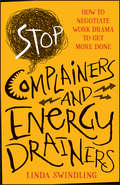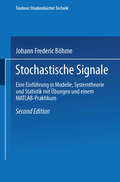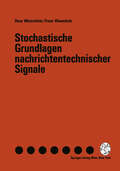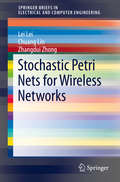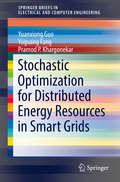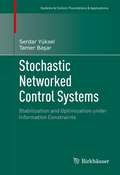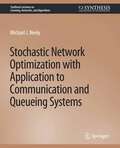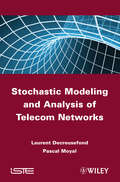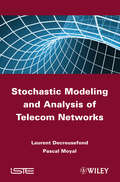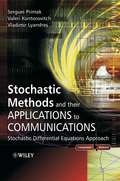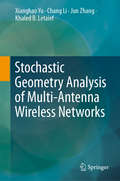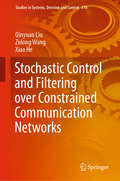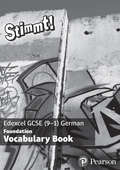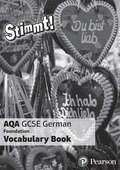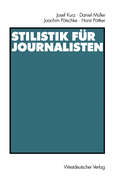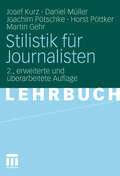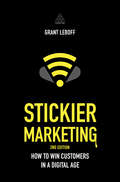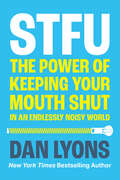- Table View
- List View
Stop Workplace Drama: Train Your Team to have No Complaints, No Excuses, and No Regrets
by Marlene ChismOvercome the interpersonal challenges holding your business back Is your workplace riddled with gossip, power struggles, and confusion? Do you seek clarity in your management and cohesiveness in your team? Do you have a personal obstacle affecting your professional success? If so, there is good news-help is on the way. Stop Workplace Drama offers down-to-earth, practical methods to help business owners, entrepreneurs, and private practice professionals maximize success, increase productivity, and improve teamwork and personal performance. Identify "drama" barriers and help your employees break free to experience higher personal effectiveness and increased productivity Each of the eight points is full of universal and practical principles any business leader, sales director or entrepreneur can put to use immediately Author Marlene Chism has shared her signature process with organizations such as McDonalds and NASA When you're in the thick of business competition, you and your team need to function freely without internal conflicts, confusions, or rivalries. Stop Workplace Drama ensures that your employees will be able to give their best to create a healthy, profitable workplace.
Stop Workplace Drama: Train Your Team to have No Complaints, No Excuses, and No Regrets
by Marlene ChismOvercome the interpersonal challenges holding your business back Is your workplace riddled with gossip, power struggles, and confusion? Do you seek clarity in your management and cohesiveness in your team? Do you have a personal obstacle affecting your professional success? If so, there is good news-help is on the way. Stop Workplace Drama offers down-to-earth, practical methods to help business owners, entrepreneurs, and private practice professionals maximize success, increase productivity, and improve teamwork and personal performance. Identify "drama" barriers and help your employees break free to experience higher personal effectiveness and increased productivity Each of the eight points is full of universal and practical principles any business leader, sales director or entrepreneur can put to use immediately Author Marlene Chism has shared her signature process with organizations such as McDonalds and NASA When you're in the thick of business competition, you and your team need to function freely without internal conflicts, confusions, or rivalries. Stop Workplace Drama ensures that your employees will be able to give their best to create a healthy, profitable workplace.
STOP PEOPLE PLEASING And Find Your Power
by Hailey Paige MageeDo you find it hard to say "no" to people? Do you tend to put others first? Do you feel guilty setting boundaries? If the answer to any of these questions is "yes", you may be a people pleaser.People-pleasing is a widespread but misunderstood response to trauma. It can have a huge impact on your mental health, showing up in common psychological conditions including anxiety, co-dependence, and depression. Left unchallenged, people-pleasing habits can lead to chronic discomfort, exhaustion, and resentment.In Stop People Pleasing, certified life coach Hailey Magee offers an action-based approach to breaking the people-pleasing pattern. Drawing on social science, psychological research, and coaching exercises, Magee gives you the practical tools you need to:- Understand the origins of your people-pleasing- Discover your own needs- Set empowered boundaries- Courageously advocate for yourselfWith fresh insight, heartfelt empathy, and a keen personal understanding of the pitfalls of people-pleasing, Magee will help you to break free from the cycle, overcome your guilt, and reconnect with your own feelings, needs, and aspirations.
Stop Complainers and Energy Drainers: How to Negotiate Work Drama to Get More Done
by Linda Byars SwindlingTurn constant complainers into productive contributors Constant complainers take up resources, time, and mental bandwidth in the workplace. When you change a culture of complainers to one of contributors, you boost morale, increase productivity, and promote effective communication. In short, you get more done with less drama. In Stop Complainers and Energy Drainers, workplace communication expert Linda Swindling shares her expertise in negotiating tough situations in the workplace. Discover how to influence others to accomplish your purpose. Stop Complainers and Energy Drainers uses scenarios, engaging questions, and survey results to provide strategies that can be implemented immediately. Shows how to identify complainers and time drainers Provides forms to help prepare for discussions, suggested language to show up powerfully, and encouragement to apply strategies Offers concrete phrases and tactics to refocus a complainer and end unproductive conversations Stop Complainers and Energy Drainers is research-driven and focused on how to identify as well as manage conversations with "venters," complainers, whiners, and energy drainers. With these guidelines for communication, you'll see powerful results, improved relationships, and increased confidence.
Stop Complainers and Energy Drainers: How to Negotiate Work Drama to Get More Done
by Linda Byars SwindlingTurn constant complainers into productive contributors Constant complainers take up resources, time, and mental bandwidth in the workplace. When you change a culture of complainers to one of contributors, you boost morale, increase productivity, and promote effective communication. In short, you get more done with less drama. In Stop Complainers and Energy Drainers, workplace communication expert Linda Swindling shares her expertise in negotiating tough situations in the workplace. Discover how to influence others to accomplish your purpose. Stop Complainers and Energy Drainers uses scenarios, engaging questions, and survey results to provide strategies that can be implemented immediately. Shows how to identify complainers and time drainers Provides forms to help prepare for discussions, suggested language to show up powerfully, and encouragement to apply strategies Offers concrete phrases and tactics to refocus a complainer and end unproductive conversations Stop Complainers and Energy Drainers is research-driven and focused on how to identify as well as manage conversations with "venters," complainers, whiners, and energy drainers. With these guidelines for communication, you'll see powerful results, improved relationships, and increased confidence.
Stochastische Signale: Eine Einführung in Modelle, Systemtheorie und Statistik mit Übungen und einem MATLAB-Praktikum (Teubner Studienbücher Technik)
by Johann Frederic BöhmeDas Buch wendet sich an Leser, die sich gründlich in die Theorie stochastischer Signale einarbeiten wollen. Im ersten Teil werden in einem Grundkurs die notwendigen Werkzeuge der Stochastik erarbeitet, im zweiten Teil stochastische Signale behandelt. Zahlreiche Beispiele, Übungsaufgaben und Lösungsskizzen, Anhänge, Tabellen für Standardverteilungen und ein Praktikum in MATLAB mit Simulationsaufgaben erleichtern das Selbststudium und die Anwendungen in der Praxis.
Stochastische Grundlagen nachrichtentechnischer Signale
by Hans Weinrichter Franz HlawatschDieses Buch bietet eine Einführung in die Theorie der statistischen Signalbeschreibung mit spezieller Betonung der digitalen Nachrichtenübertragungstechnik. Im ersten Kapitel wird der Begriff eines nachrichtentechnischen Signals und seine Beschreibungsmöglichkeiten kurz erläutert. Das zweite Kapitel geht speziell auf den Aspekt der Zufälligkeit und Unbestimmtheit von Signalen ein. Dabei wird die praktische Anwendung der Wahrscheinlichkeitstheorie auf die fundamentalen Probleme der Nachrichtenübertragung dargestellt. Der Begriff der Information und seine Anwendung auf Quellencodierung und Kanalkapazität werden anhand einfacher Beispiele erklärt. Das dritte Kapitel führt den Begriff der Zufallsvariablen und ihrer Beschreibung durch Verteilungsfunktion, Wahrscheinlichkeitsdichte und Erwartungswerte ein. Anschließend werden die Grundgedanken der Schätzung von Parametern von Verteilungsfunktionen und charakteristische Eigenschaften wie Varianz und Bias erklärt. Weitere Kapitel befassen sich mit der Modellierung von Nutzsignalen und Störungen, wichtigen Beschreibungsmöglichkeiten wie AKF und Leistungsdichtespektrum sowie speziellen stochastischen Prozessen und deren mathematischer Beschreibung. Abschließend werden noch binäre Pseudozufallsfolgen sowie die Anwendung des Konzepts stochastischer Prozesse auf den Entwurf von Systemen zur Signalverarbeitung diskutiert. Bei der Aufbereitung des Stoffes wurde auf größtmögliche Anschaulichkeit und Lesbarkeit Wert gelegt. Die Beschreibung der angesprochenen Sachverhalte wurde soweit formalisiert, daß dem Leser ein tieferes Endringen in weiterführende Litertur ohne Probleme möglich sein wird.
Stochastic Petri Nets for Wireless Networks (SpringerBriefs in Electrical and Computer Engineering)
by Lei Lei Chuang Lin Zhangdui ZhongThis SpringerBrief presents research in the application of Stochastic Petri Nets (SPN) to the performance evaluation of wireless networks under bursty traffic. It covers typical Quality-of-Service performance metrics such as mean throughput, average delay and packet dropping probability. Along with an introduction of SPN basics, the authors introduce the key motivation and challenges of using SPN to analyze the resource sharing performance in wireless networks. The authors explain two powerful modeling techniques that treat the well-known state space explosion problem: model decomposition and iteration, and model aggregation using stochastic high-level petri nets. The first technique assists in performance analysis of opportunistic scheduling, Device-to-Device communications with full frequency reuse and partial frequency reuse. The second technique is used to formulate a wireless channel mode for cross-layer performance analysis in OFDM system. Stochastic Petri Nets for Wireless Networks reveals useful insights for the design of radio resource management algorithms and a new line of thinking for the performance evaluation of future wireless networks. This material is valuable as a reference for researchers and professionals working in wireless networks and for advanced-level students studying wireless technologies in electrical engineering or computer science.
Stochastic Optimization for Distributed Energy Resources in Smart Grids (SpringerBriefs in Electrical and Computer Engineering)
by Yuanxiong Guo Yuguang Fang Pramod P. KhargonekarThis brief focuses on stochastic energy optimization for distributed energy resources in smart grids. Along with a review of drivers and recent developments towards distributed energy resources, this brief presents research challenges of integrating millions of distributed energy resources into the grid. The brief then proposes a novel three-level hierarchical architecture for effectively integrating distributed energy resources into smart grids. Under the proposed hierarchical architecture, distributed energy resource management algorithms at the three levels (i.e., smart home, smart neighborhood, and smart microgrid) are developed in this brief based on stochastic optimization that can handle the involved uncertainties in the system.
Stochastic Networked Control Systems: Stabilization and Optimization under Information Constraints (Systems & Control: Foundations & Applications)
by Serdar Yüksel Tamer BaşarNetworked control systems are increasingly ubiquitous today, with applications ranging from vehicle communication and adaptive power grids to space exploration and economics. The optimal design of such systems presents major challenges, requiring tools from various disciplines within applied mathematics such as decentralized control, stochastic control, information theory, and quantization. A thorough, self-contained book, Stochastic Networked Control Systems: Stabilization and Optimization under Information Constraints aims to connect these diverse disciplines with precision and rigor, while conveying design guidelines to controller architects. Unique in the literature, it lays a comprehensive theoretical foundation for the study of networked control systems, and introduces an array of concrete tools for work in the field. Salient features included: · Characterization, comparison and optimal design of information structures in static and dynamic teams. Operational, structural and topological properties of information structures in optimal decision making, with a systematic program for generating optimal encoding and control policies. The notion of signaling, and its utilization in stabilization and optimization of decentralized control systems. · Presentation of mathematical methods for stochastic stability of networked control systems using random-time, state-dependent drift conditions and martingale methods. · Characterization and study of information channels leading to various forms of stochastic stability such as stationarity, ergodicity, and quadratic stability; and connections with information and quantization theories. Analysis of various classes of centralized and decentralized control systems. · Jointly optimal design of encoding and control policies over various information channels and under general optimization criteria, including a detailed coverage of linear-quadratic-Gaussian models. · Decentralized agreement and dynamic optimization under information constraints. This monograph is geared toward a broad audience of academic and industrial researchers interested in control theory, information theory, optimization, economics, and applied mathematics. It could likewise serve as a supplemental graduate text. The reader is expected to have some familiarity with linear systems, stochastic processes, and Markov chains, but the necessary background can also be acquired in part through the four appendices included at the end. · Characterization, comparison and optimal design of information structures in static and dynamic teams. Operational, structural and topological properties of information structures in optimal decision making, with a systematic program for generating optimal encoding and control policies. The notion of signaling, and its utilization in stabilization and optimization of decentralized control systems. · Presentation of mathematical methods for stochastic stability of networked control systems using random-time, state-dependent drift conditions and martingale methods. · Characterization and study of information channels leading to various forms of stochastic stability such as stationarity, ergodicity, and quadratic stability; and connections with information and quantization theories. Analysis of various classes of centralized and decentralized control systems. · Jointly optimal design of encoding and control policies over various information channels and under general optimization criteria, including a detailed coverage of linear-quadratic-Gaussian models. · Decentralized agreement and dynamic optimization under information constraints. This monograph is geared toward a broad audience of academic and industrial researchers interested in control theory, information theory, optimization, economics, and applied mathematics. It
Stochastic Network Optimization with Application to Communication and Queueing Systems (Synthesis Lectures on Learning, Networks, and Algorithms)
by Michael NeelyThis text presents a modern theory of analysis, control, and optimization for dynamic networks. Mathematical techniques of Lyapunov drift and Lyapunov optimization are developed and shown to enable constrained optimization of time averages in general stochastic systems. The focus is on communication and queueing systems, including wireless networks with time-varying channels, mobility, and randomly arriving traffic. A simple drift-plus-penalty framework is used to optimize time averages such as throughput, throughput-utility, power, and distortion. Explicit performance-delay tradeoffs are provided to illustrate the cost of approaching optimality. This theory is also applicable to problems in operations research and economics, where energy-efficient and profit-maximizing decisions must be made without knowing the future. Topics in the text include the following: - Queue stability theory - Backpressure, max-weight, and virtual queue methods - Primal-dual methods for non-convex stochastic utility maximization - Universal scheduling theory for arbitrary sample paths - Approximate and randomized scheduling theory - Optimization of renewal systems and Markov decision systems Detailed examples and numerous problem set questions are provided to reinforce the main concepts. Table of Contents: Introduction / Introduction to Queues / Dynamic Scheduling Example / Optimizing Time Averages / Optimizing Functions of Time Averages / Approximate Scheduling / Optimization of Renewal Systems / Conclusions
Stochastic Modeling and Analysis of Telecom Networks
by Laurent Decreusefond Pascal MoyalThis book addresses the stochastic modeling of telecommunication networks, introducing the main mathematical tools for that purpose, such as Markov processes, real and spatial point processes and stochastic recursions, and presenting a wide list of results on stability, performances and comparison of systems. The authors propose a comprehensive mathematical construction of the foundations of stochastic network theory: Markov chains, continuous time Markov chains are extensively studied using an original martingale-based approach. A complete presentation of stochastic recursions from an ergodic theoretical perspective is also provided, as well as spatial point processes. Using these basic tools, stability criteria, performance measures and comparison principles are obtained for a wide class of models, from the canonical M/M/1 and G/G/1 queues to more sophisticated systems, including the current “hot topics” of spatial radio networking, OFDMA and real-time networks. Contents 1. Introduction. Part 1: Discrete-time Modeling 2. Stochastic Recursive Sequences. 3. Markov Chains. 4. Stationary Queues. 5. The M/GI/1 Queue. Part 2: Continuous-time Modeling 6. Poisson Process. 7. Markov Process. 8. Systems with Delay. 9. Loss Systems. Part 3: Spatial Modeling 10. Spatial Point Processes.
Stochastic Modeling and Analysis of Telecom Networks
by Laurent Decreusefond Pascal MoyalThis book addresses the stochastic modeling of telecommunication networks, introducing the main mathematical tools for that purpose, such as Markov processes, real and spatial point processes and stochastic recursions, and presenting a wide list of results on stability, performances and comparison of systems. The authors propose a comprehensive mathematical construction of the foundations of stochastic network theory: Markov chains, continuous time Markov chains are extensively studied using an original martingale-based approach. A complete presentation of stochastic recursions from an ergodic theoretical perspective is also provided, as well as spatial point processes. Using these basic tools, stability criteria, performance measures and comparison principles are obtained for a wide class of models, from the canonical M/M/1 and G/G/1 queues to more sophisticated systems, including the current “hot topics” of spatial radio networking, OFDMA and real-time networks. Contents 1. Introduction. Part 1: Discrete-time Modeling 2. Stochastic Recursive Sequences. 3. Markov Chains. 4. Stationary Queues. 5. The M/GI/1 Queue. Part 2: Continuous-time Modeling 6. Poisson Process. 7. Markov Process. 8. Systems with Delay. 9. Loss Systems. Part 3: Spatial Modeling 10. Spatial Point Processes.
Stochastic Methods and their Applications to Communications: Stochastic Differential Equations Approach
by Serguei Primak Valeri Kontorovich Vladimir LyandresStochastic Methods & their Applications to Communications presents a valuable approach to the modelling, synthesis and numerical simulation of random processes with applications in communications and related fields. The authors provide a detailed account of random processes from an engineering point of view and illustrate the concepts with examples taken from the communications area. The discussions mainly focus on the analysis and synthesis of Markov models of random processes as applied to modelling such phenomena as interference and fading in communications. Encompassing both theory and practice, this original text provides a unified approach to the analysis and generation of continuous, impulsive and mixed random processes based on the Fokker-Planck equation for Markov processes. Presents the cumulated analysis of Markov processes Offers a SDE (Stochastic Differential Equations) approach to the generation of random processes with specified characteristics Includes the modelling of communication channels and interfer ences using SDE Features new results and techniques for the of solution of the generalized Fokker-Planck equation Essential reading for researchers, engineers, and graduate and upper year undergraduate students in the field of communications, signal processing, control, physics and other areas of science, this reference will have wide ranging appeal.
Stochastic Geometry Analysis of Multi-Antenna Wireless Networks
by Xianghao Yu Chang Li Jun Zhang Khaled B. LetaiefThis book presents a unified framework for the tractable analysis of large-scale, multi-antenna wireless networks using stochastic geometry. This mathematical analysis is essential for assessing and understanding the performance of complicated multi-antenna networks, which are one of the foundations of 5G and beyond networks to meet the ever-increasing demands for network capacity. Describing the salient properties of the framework, which makes the analysis of multi-antenna networks comparable to that of their single-antenna counterparts, the book discusses effective design approaches that do not require complex system-level simulations. It also includes various application examples with different multi-antenna network models to illustrate the framework’s effectiveness.
Stochastic Control and Filtering over Constrained Communication Networks (Studies in Systems, Decision and Control #178)
by Qinyuan Liu Zidong Wang Xiao HeStochastic Control and Filtering over Constrained Communication Networks presents up-to-date research developments and novel methodologies on stochastic control and filtering for networked systems under constrained communication networks. It provides a framework of optimal controller/filter design, resilient filter design, stability and performance analysis for the systems considered, subject to various kinds of communication constraints, including signal-to-noise constraints, bandwidth constraints, and packet drops. Several techniques are employed to develop the controllers and filters desired, including:recursive Riccati equations;matrix decomposition;optimal estimation theory; andmathematical optimization methods.Readers will benefit from the book’s new concepts, models and methodologies that have practical significance in control engineering and signal processing. Stochastic Control and Filtering over Constrained Communication Networks is a practical research reference for engineers dealing with networked control and filtering problems. It is also of interest to academics and students working in control and communication networks.
Stimmt! Edexcel GCSE German Foundation Vocabulary Book (PDF)
by Pearson EducationKey vocabulary arranged by topic. Ensures students always have the vocabulary they need for learning and revision. Vocabulary Books available in packs of 8.
Stimmt! AQA GCSE German Foundation Vocabulary Book (PDF)
by Pearson EducationA handy vocabulary learning tool containing key vocabulary. Key vocabulary arranged by topic. Ensures students always have the vocabulary they need for learning and revision. Vocabulary Books available in packs of 8.
Stilistik für Journalisten
by Josef Kurz Daniel Müller Joachim Pötschke Horst PöttkerSprache ist das wichtigste Handwerkszeug des Journalisten, sie gekonnt zu handhaben die Grundlage für seinen Beruf und die Bewältigung seiner Aufgabe: das Herstellen von Öffentlichkeit. Dieses Lehrbuch ist die derzeit umfassendste Darstellung der journalistischen Stilkunde. Alle wichtigen Bereiche des journalistischen Sprachgebrauchs werden behandelt: Von der Wortwahl über die Satz- und Textgestaltung bis zu Stilverfahren bestimmter Genres wie Nachricht oder Kommentar und zum Jargon von Politikern. Die Stilistik ist für die journalistische Aus- und Weiterbildung sowie als Handbuch für den Gebrauch im Arbeitsalltag gedacht.
Stilistik für Journalisten
by Josef Kurz Daniel Müller Joachim Pötschke Horst Pöttker Martin GehrSprache ist neben dem Bild das wichtigste Handwerkszeug des Journalisten, sie gekonnt zu handhaben stellt die Grundlage für seine Berufstätigkeit und die Erfüllung seiner Aufgabe dar: das Herstellen von Öffentlichkeit. Dieses Lehrbuch ist die derzeit umfassendste Darstellung der journalistischen Stilkunde. Alle wichtigen Bereiche des journalistischen Sprachgebrauchs werden behandelt: von der Wortwahl über die Satz- und Textgestaltung bis zu Stilverfahren bestimmter Genres wie Nachricht, Kommentar oder Reportage und zum Jargon von Politikern. Die Stilistik ist für die journalistische Aus- und Weiterbildung sowie als Handbuch für den Gebrauch im Arbeitsalltag gedacht.
Stickier Marketing: How to Win Customers in a Digital Age
by Grant LeboffIn Sticky Marketing Grant Leboff argued that the old marketing system of shouting messages at people was finished, replaced by providing value around your product or service: brands needed to become sticky. This new edition of Sticky Marketing, Stickier Marketing, remains a complete guide to producing effective marketing communications in a world of consumers empowered by new digital technology who do not want to be shouted at but engaged with. It shows readers how providing return on engagement, rather than return on investment, and a customer engagement point, rather than a unique selling point, is what will make the difference in today's cluttered marketing place. Updated throughout, this new edition also includes brand new chapters on content marketing, discovery and mobile marketing.
Stickier Marketing: How to Win Customers in a Digital Age
by Grant LeboffIn Sticky Marketing Grant Leboff argued that the old marketing system of shouting messages at people was finished, replaced by providing value around your product or service: brands needed to become sticky. This new edition of Sticky Marketing, Stickier Marketing, remains a complete guide to producing effective marketing communications in a world of consumers empowered by new digital technology who do not want to be shouted at but engaged with. It shows readers how providing return on engagement, rather than return on investment, and a customer engagement point, rather than a unique selling point, is what will make the difference in today's cluttered marketing place. Updated throughout, this new edition also includes brand new chapters on content marketing, discovery and mobile marketing.
Stick It Up Your Punter!: The Uncut Story of the Sun Newspaper
by Chris Horrie Peter ChippindaleNewly updated to 2012 and the Leveson Inquiry, Stick It Up Your Punter! is the classic story of the Sun newspaper, its part in the rise of Rupert Murdoch's business empire, and the extraordinary role it came to play in British society and politics. From Murdoch's purchase and rebranding of the old loss-making Sun in 1969, through the soaraway-successful and often scandalous years of success under foul-mouthed editor Kelvin MacKenzie, to the 'phone-hacking' disgrace of 2012 which put Murdoch's business affairs under scrutiny as never before - this is the story of the paper that, for better or worse, redefined 'tabloid journalism'.'[This] anarchic account... could be a script for Carry On Up Fleet Street.' Alan Rusbridger, Guardian'The funniest book of the year, perhaps of the decade.' Times'Splendidly racy.' Economist'A story which social and political historians of the 20th century will not find easy to ignore.' London Review of Books
STFU: The Power Of Keeping Your Mouth Shut In A World That Won't Stop Talking
by Dan LyonsWould our lives, relationships and careers be better if we just STFU for a while?
Steuerungstechnik für Ingenieure: Ein Überblick (essentials)
by Bernd SchröderFür selbstarbeitende und automatisierte (Produktions-) Prozesse werden Steuerungstechniken genutzt. Die hierzu eingesetzten Elemente arbeiten mechanisch, pneumatisch, hydraulisch, elektrisch oder elektronisch. Ausführende Organe sind unter anderem Ventile, Pumpen, Motore, Schalter, Sensoren und Relais. Die hierfür gängigen Symbole werden vorgestellt und können in Schemata eingesetzt werden. Gelegentlich ist die Erstellung sequenzieller Schaltungen hilfreich. Für eine hohe Flexibilität bietet sich die speicherprogrammierbare Steuerung (SPS) an.


